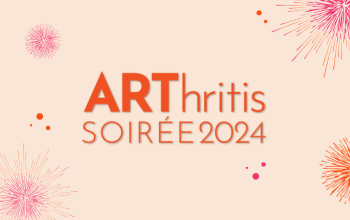Getting to know Rheumatologist, Dr. Laëtitia Michou
What struck me during my interview with Rheumatologist Laëtitia Michou
In May 2019, I had the opportunity to have a telephone interview with Dr. Laëtitia Michou, a rheumatologist and clinical researcher at CHU de Québec-Université Laval for 12 years. Dr. Michou has also been a researcher at Arthritis Research Canada since June 2019.
This interview allowed me to demystify and better understand the work of a clinical researcher. I was impressed by the extent to which research is a calling but also a reality that patients cannot imagine.
Becoming a Researcher: A Journey Fraught with Difficulties.
 Arthritis research is carried out by two types of researchers: clinical researchers and basic researchers.
Arthritis research is carried out by two types of researchers: clinical researchers and basic researchers.
If a clinician wants to do research on arthritis and thus become a clinician-scientist, the path is long because they must be trained in rheumatology in both clinical practice and research. They will start their career around the age of 35. In Québec, a clinician has to apply for research grants from public institutions such as the Fonds de Recherche du Québec – Santé (FRQS) or the Canadian Institutes of Health Research (CIHR). Each grant application requires about 250 hours of work, with either no or very little administrative support. The success rate is on being successful on these grants is very low – around 10%. The successful application is not only graded on the content of the project, but also on the form and presentation of the document. Consequently, the experience of the researcher is important and new researchers may be at a disadvantage in some competitions. A clinical researcher shares their time between seeing patients in their clinic and the research with their research team.
Basic researchers who work on arthritis have academic training in different areas of biological sciences and hold a PhD. Most are not clinicians. They pursued their training during postdoctoral fellowships which allowed them to acquire a specialization in a field of research related to arthritis from which they will develop their project as a researcher. For them too, the road is long and difficult. They work in a laboratory with a research team made up of students and research professionals.
Becoming a Researcher: A Vocation
Through Dr. Michou’s words, I felt how research is a vocation and can become a passion. Yet, the life of the clinical researcher requires a lot of organization and compromise. Their evenings and weekends are often sacrificed because of the workload.
She mentioned that her clinical practice was a source of inspiration and that some ideas come from discussion with her patients, proof of the richness of this profession.
Teaching is also part of the mission of the clinical researcher. The transfer of knowledge allows students to become catalysts for research projects.
What does the future hold for research?
The competition between researchers is real. This may seem like nonsense for patients, especially since paradoxically teamwork is essential. As a patient, this competitive aspect is surprising and seems to go against improving the knowledge and the quality of the care we want.
Dr. Michou also mentioned that in Canada, there are too few laboratories in the field of rheumatology. In particular, clinical researchers develop projects outside laboratory spaces, which creates a distance between basic and clinical research. This is something we would like to see improved in the years to come.
As patients, we would like researchers to focus solely on their research and be relieved of administrative tasks. This is an issue that should be taken into account to optimize the work of researchers.
It is clear that research will improve practice, provide new tools that will continue to evolve for the benefit of patients, practitioners and all health professionals working in the field of rheumatology. As life expectancy continues to grow, improving care for patients with chronic conditions such as arthritis will benefit all Canadians.
France Gervais
President of PIRA


























































